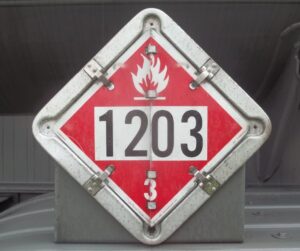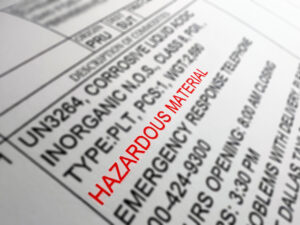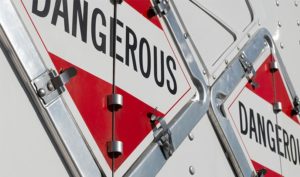
Placard displaying the number 1203 with a flame symbol.
Navigating the complex world of HazMat regulations can be intricate, especially when merging with LTL (Less Than Truckload) services. Sutton Transport has honed its HazMat LTL expertise in this area to ensure impeccable compliance and efficient transport.
Starting the Journey: The Importance of the BOL
The journey begins with the pickup. It’s essential that our drivers meticulously examine the Bill of Lading (BOL). This document serves as a pivotal touchpoint, identifying if the shipment aligns with the company’s stringent regulations. Following this, our dedicated customer service personnel take charge, entering and coding the shipment with utmost precision in our state-of-the-art system.

From Dispatch to Delivery: Ensuring Compliance Every Step of the Way
But that’s not where our responsibility ends. The dispatch phase comes next. Our advanced system flags HazMat shipments to alert the delivery driver. It’s paramount for our drivers to be in the loop, as they’re the ones ensuring the commercial vehicle is placarded in line with DOT requirements. Furthermore, they’re mandated to keep the (ERG) Emergency Response Guidebook alongside shipping papers within arm’s reach, catering to any inspection needs.
LTL Service Requirements: More Than Just Transportation
Did you know that an LTL service provider armed with HazMat LTL expertise must have an array of placards on standby to cater to diverse requirements? On top of this, there’s a need to regularly update the ERG books – with the upcoming edition due in 2024.

The Sutton Advantage: Spanning States with Expertise
Proudly, Sutton Transport operates with a vast fleet of 350 power units, spread across 13 terminals in 4 states. We’re backed by an outstanding team of approximately 450 CDL holders. To keep this vast network updated – from drivers and terminal staff to sales and support units – with evolving HazMat requirements, we deploy diverse tools. Regular meetings, consistent communication, terminal TVs, and streamlined workflow processes are just a few in our arsenal.

Responsibilities Decoded: Shipper vs. Carrier
HazMat Shipper Responsibilities:
- Determine whether a material meets the definition of a “hazardous material”
- Proper shipping name
- Class/division
- Identification number
- Hazard warning label
- Packaging
- Marking
- Employee training
- Shipping papers
- Emergency response information
- Emergency response telephone number
- Certification
- Compatibility
- Blocking and bracing
- Placarding
- Security plan
- Incident reporting
HazMat Carrier Responsibility:
- Shipping paper
- Placard and mark vehicle
- Loading and unloading
- Compatibility
- Blocking and bracing
- Incident reporting
- Security plan
- Employee training
Commitment Beyond Compliance: The Sutton Transport Promise
At Sutton Transport, we perceive HazMat regulations not merely as rules but as a testament to safety and excellence. Every department, enriched with HazMat LTL expertise – Fleet, Customer Service, Operations, Safety, Sales, Marketing, and Human Resources – collaboratively ensures we exceed customer expectations for their HazMat shipping needs.
Looking for a partner who understands the intricacies of HazMat and LTL shipping? Connect with Sutton Transport. Call 1-800-472-6886 or visit www.suttontrans.com. Let’s simplify your shipping journey.